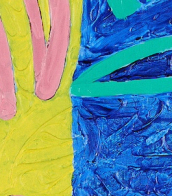Graphics — Auction price
Lot 198 2 Holzschnitte von Dolberg, Helene (1881 Barkow-1979 Hildesheim) "Thomaskirche Leipzig", sign. u.r. und bez. u.l., 22x17 cm, im Passepartout hinter Glas und Rahmen und "Hünengrab an Küste", sign. u.r.…
Kunst und Antiquitäten 

Auktionshaus Satow
Kunst und Antiquitäten
Date: 15.11.2025 11:00 UTC +01:00
Number of lots in the catalog: 1075
Lot 200 Grunwaldt, Herbert (1928 Bunzlau-2014 Hamburg) "Kreideküste von Mön", Farbradierung, handsign. u.r., 23,5x28 cm, ungerahmt (Deutscher Maler unter Grafik. Studium an der Hochschule für Bildende Künste Hamburg)…
Kunst und Antiquitäten 

Auktionshaus Satow
Kunst und Antiquitäten
Date: 15.11.2025 11:00 UTC +01:00
Number of lots in the catalog: 1075
Lot 203 Stegemann, Heinrich (1888 Hamburg-1945 ebenda) "Weibliches Kopfprofil vor Häusern", Holzschnitt, bez. "Einmalige Auflage für die Griffelkunst 1996", unsig., verso. Nachlaßstempel, 27x22 cm, Blattgröße…
Kunst und Antiquitäten 

Auktionshaus Satow
Kunst und Antiquitäten
Date: 15.11.2025 11:00 UTC +01:00
Number of lots in the catalog: 1075
Lot 206 Austen, Rudolf (1931 Hainspach-2003 Rostock) "Drachen über der Stadt", Radierung, 3/15, sign. u.r., dat. 1978, 33x26 cm, hnter Glas und Rahmen (freischaffend ab 1958 als Maler und Grafiker in Rostock, Beteiligu…
Kunst und Antiquitäten 

Auktionshaus Satow
Kunst und Antiquitäten
Date: 15.11.2025 11:00 UTC +01:00
Number of lots in the catalog: 1075
Lot 207 "Prospekt der Fürstl. Meckl. Resid. Statt Schwerin", Druck vor Schloßbrand Mitte 19. Jh., u.l. bez. "Casp: Merian fecit" und am Blattrand "1359a-W.A. Beckert, Weimar-B 876", 22,5x35 cm, unge…
Kunst und Antiquitäten 

Auktionshaus Satow
Kunst und Antiquitäten
Date: 15.11.2025 11:00 UTC +01:00
Number of lots in the catalog: 1075
Lot 208 Mappe mit 4 Drucken"Hamburg", dabei Blick nach der Steinstraße, Hamburger Hof, Steinstraße Hof 69 und Alte Stahltreppe, jeweils unten rechts bez., jeweils 27x17 cm
Kunst und Antiquitäten 

Auktionshaus Satow
Kunst und Antiquitäten
Date: 15.11.2025 11:00 UTC +01:00
Number of lots in the catalog: 1075
Lot 210 Münch, Armin (1930 Rabenau-2013 Rostock) 3 Grafiken mit figürlich, abstrakten Darstellungen, jeweils mit Bleistift sign., 23,5x18 cm bis 49,5x38 cm, ungerahmt (Studium 1950-1955 an Hochschule für bildende Künste in Dresd…
Kunst und Antiquitäten 

Auktionshaus Satow
Kunst und Antiquitäten
Date: 15.11.2025 11:00 UTC +01:00
Number of lots in the catalog: 1075
Lot 211 Paris, Ronald (1933 Sonderhausen-2021 Rangsdorf bei Berlin) 2 Grafiken "Zu I. Babel Reiterarmee", 53/ 75, sign. u.r. und dat. ´77 und "Odysseus und die Siren (V)", 15/ 15, sign. u.r. und dat. ´77, Bla…
Kunst und Antiquitäten 

Auktionshaus Satow
Kunst und Antiquitäten
Date: 15.11.2025 11:00 UTC +01:00
Number of lots in the catalog: 1075
Lot 212 Paris, Ronald (1933 Sondershausen-2021 Rangsdorf bei Berlin) 2 Grafiken "Freundeskreis Bildende Kunst Wernigerode", 11/ 130, sign. u.r. und dat. ´81, Knickspur am oberen Rand links, 49x35 cm und "Apollon u…
Kunst und Antiquitäten 

Auktionshaus Satow
Kunst und Antiquitäten
Date: 15.11.2025 11:00 UTC +01:00
Number of lots in the catalog: 1075
Lot 214 Miro, Joan (1893 Barcelona-1983 Palma) "Frau, Vogel und Stern", Litho., 46/ 50, in der Platte sign., Blatt an den Rändern gewellt, 36x26 cm, im Passepartout hinter Glas und Rahmen
Kunst und Antiquitäten 

Auktionshaus Satow
Kunst und Antiquitäten
Date: 15.11.2025 11:00 UTC +01:00
Number of lots in the catalog: 1075
Lot 215 Austen, Rudolf (1931 Hainspach-2003 Rostock) "Gewitterstimmung", Radierung, sign. u.r. und dat. ´71, 22x28 cm, im Passepatout hinter Glas und Rahmen (freischaffend ab 1958 als Maler und Grafiker in Rostock, Bet…
Kunst und Antiquitäten 

Auktionshaus Satow
Kunst und Antiquitäten
Date: 15.11.2025 11:00 UTC +01:00
Number of lots in the catalog: 1075







































